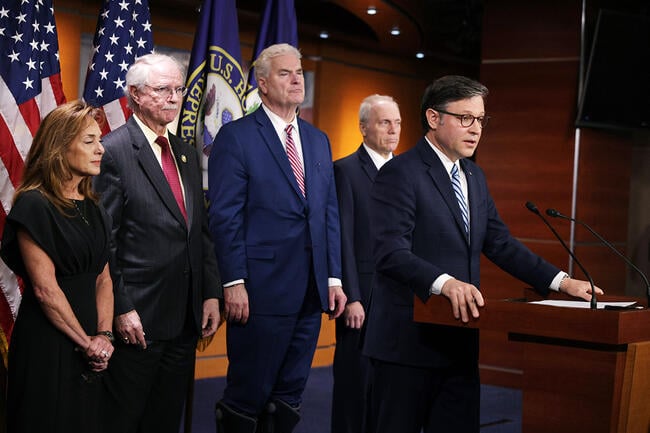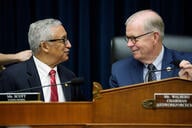You have /5 articles left.
Sign up for a free account or log in.

House Republicans have introduced plans that would greatly increase the cost of attending college for many students, experts say.
Alex Wong/Getty Images
All the pieces of House Republicans’ plan to cut trillions in federal spending are now public, and if the package becomes law, colleges and universities could face crippling repercussions, higher education experts say.
“It is a full-out assault on the ability of students—especially low-income students—to access and afford higher education,” said Jon Fansmith, senior vice president for government relations and national engagement at the American Council on Education. “It will have a dramatically negative impact, not just on higher ed, but on the whole population.”
From overhauling the federal student loan system to expanding taxes on colleges and slashing critical public benefit programs, the package could have a multitude of effects, both direct and downstream, that could hinder students’ access to postsecondary education.
Key Republican leaders say the cuts are necessary to rein in the country’s ballooning deficit. Not only would they benefit taxpayers by maintaining the Trump administration’s 2017 tax cuts, lawmakers say, but they also will end what they see as wasteful spending and roll back regulations that were a demonstration of executive overreach during the Biden administration.
“Since day one, President Trump has been crystal clear in his priorities to bring tangible reform to this broken system. The budget reconciliation process gives us a key opportunity to rightsize this sinking ship and implement the America First agenda,” Rep. Tim Walberg, a Michigan Republican and chair of the Committee on Education and the Workforce, said late last month.
But not all Republicans are on board, and Democrats are expected to oppose the legislation, which congressional leaders want to pass under reconciliation—a procedure that allows them to avoid a filibuster and pass with only 51 votes in the Senate. The end goal is to set aside enough dollars to fund more than $4 trillion in tax cuts and immigration reform.
Lawmakers have been brainstorming the bill since January, but its complexities have slowed down the process. House Speaker Mike Johnson was originally aiming to send the legislation to President Donald Trump by Memorial Day. Now, he’s just hoping to get it out of the House by then.
House committees worked Tuesday and Wednesday in order to pass their respective bills—one committee worked 18 hours nonstop through the night. Now, the House budget committee will stitch the plans together. House leaders want to put the omnibus bill up for a vote next week. If the House approves what leaders are referring to as the “one big, beautiful bill,” the measure will head to the Senate, where it’s expected to see many changes.
That said, here’s what we know for now about how the proposed plans could affect colleges and universities.
Taxing IP and Endowments
Some of the most critical provisions of the reconciliation come from the Ways and Means Committee, which is largely focused on tax policy. Unveiled Monday, its proposal introduced, repealed and amended a host of tax policies—many of which concerned colleges and universities.
One tax expert told Inside Higher Ed that the Ways and Means Committee’s legislation was “trying to tax colleges and universities at every single turn despite the net good they do and the academic mission they uphold.”
Rep. Lloyd Doggett, a Texas Democrat and ranking member of the committee, said the proposals give the Trump administration “dangerous new authority to impose capital punishment on nonprofit universities.”
Seemingly the most notable and direct attack on higher ed is a proposed increase and expansion of the college endowment tax. Originally passed in 2017, the tax currently affects private universities whose endowments are worth more than $500,000 per student at a rate of 1.4 percent.
About 50 colleges are currently subject to the tax, but under the proposed provision, that number would likely grow, as the revamped formula would exclude international students from the count. The new legislation also increases the total tax rate to up to 21 percent, depending on endowment size.
But there are other provisions that experts say could also exact a toll from a broader range of higher ed institutions.
For example, one grants the secretary of Treasury the authority to revoke any 501(c)(3) nonprofit of its tax-exempt status if it is deemed a “supporter of terrorism.” This revocation can be exercised at the secretary’s discretion and requires an accused institution to prove its innocence rather than the government to prove guilt. The definition of what qualifies as supporting terrorism is also vague, higher ed experts said.
“It could be used in improper and abusive ways to punish tax-exempt organizations,” said Steven Bloom, assistant vice president of government relations at ACE.
Fear of this kind of weaponization is especially high among colleges and universities as they wrestle with drawing a fine line between protecting Jewish students from antisemitism and protecting the First Amendment rights of pro-Palestinian protesters whom the Trump administration has accused of supporting Hamas.
The proposal also taxes a college’s intellectual property by stating that the endowment tax should include all forms of investment income. This means that any royalties from a private university’s intellectual property, including patents and copyrights, would be taxable.
Additionally, the legislation removes colleges’ exemption from the unrelated business income tax so that all institutions, public and private, would be taxed for royalties from licensing their name and logo. This means that an institution like the University of North Carolina at Chapel Hill, which puts its trademark profits toward student scholarships, would have to set some of that revenue aside to pay its taxes.
“I’m worried this is a test run to tax all royalties at all institutions,” one source told Inside Higher Ed. Another said that these policies would just “hit students again and again and again.”
Cutting Medicaid and SNAP
The Energy and Commerce and Agriculture Committees are eyeing big cuts to the Medicaid and Supplemental Nutrition Assistance programs, which could lose up to $880 billion and $230 billion respectively over the next decade
Nearly one in six student depends on Medicaid for health insurance, according to ACE; and about one in four students faces food insecurity and could benefit from access to SNAP, the Institute for College Access and Success said in a news release.
“The loss of food and health-care benefits will create immediate health and well-being consequences for those who rely on them,” TICAS senior vice president Jessica Thompson explained. “With this move, the House threatens long-term damage by undermining low-income students’ ability to complete a degree or credential, making economic mobility harder to achieve.”
Furthermore, policy experts say these federal cuts could lead to less state funding, which could hurt institutions. States depend heavily on federal dollars to maintain their food security and health-care programs. If funding for Medicaid and SNAP are cut, state officials will be forced to either shrink the number of constituents they serve or pull funding from other areas of the budget.
Historically, when state lawmakers are looking to move funds from one sector to another, higher ed is one of the first areas to be chopped.
“This is a top-tier issue for state higher education leaders, perhaps the biggest issue in the entire reconciliation package,” said Tom Harnisch, vice president for government relations at the State Higher Education Executive Officers Association. “Higher education funding will be a prime target to help fill in gaps … as public colleges and universities have alternative revenue streams in the form of student tuition and fees.”
Recent data from SHEEO shows a slight increase in state funding for institutions over the past year, but over all, the share of state funding dedicated to higher education has dropped. Harnisch expects the proposed cuts to accelerate that trend. In the end, he said, students will take the blow.
“Combined with financial aid cuts proposed elsewhere in the reconciliation bill, college students could be on the hook for significantly more costs in the years ahead,” he said.
Overhauling Student Loans
The reconciliation proposals that most directly impact higher education institutions come from the Committee on Education and the Workforce.
Released and advanced to the budget committee at the end of April, this section would completely overhaul the federal student loan system, dramatically reduce the number of students who qualify for full Pell Grants and charge colleges a new fee for their graduates’ unpaid loans.
Higher ed lobbyists from all areas of the industry—including for-profit institutions—are opposed to the legislation. Many say that collectively, the committee’s proposals would be devastating—especially to institutions that largely serve low-income students.
The committee’s plan deals the most direct blow to colleges and universities while the other changes proposed by the Ways and Means, Commerce, and Agriculture Committees would only make it worse. Together, they would reshape the American higher education system.
“People defend these policies one-on-one,” Fansmith from ACE said. “But if you look at what the cumulative impact of this will be, it’s that lots of students will not be able to afford higher education anymore. And students who will still pursue it will pay significantly more to do that.”




